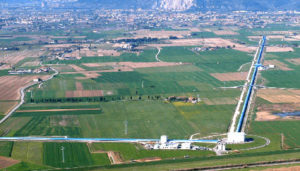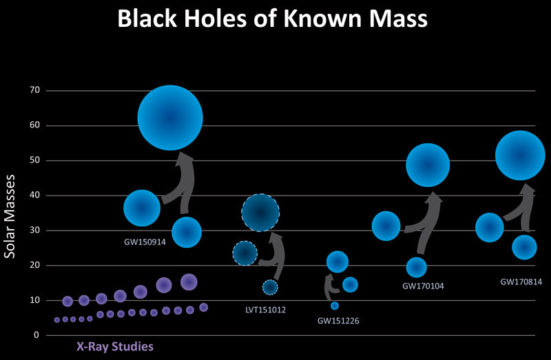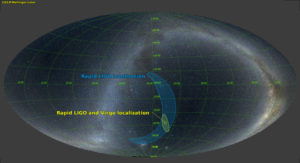Teaming up with LIGO, Europe’s Virgo detector has bagged its first gravitational waves. The three-observatory detection enabled scientists to better pinpoint the merging black holes’ location.

Virgo Collaboration
For the first time ever, gravitational waves have been observed simultaneously by three detectors, enabling a relatively accurate localization on the sky. GW170814, as the signal is officially known, was also the very first gravitational wave "felt" by the Advanced Virgo detector of the European Gravitational Observatory near Pisa, Italy.
According to a Physical Review Letters paper by the LIGO-Virgo Collaboration, the gravitational waves that reached Earth on Monday, August 14th, at 10:30:43 UT were unleashed by the collision of two black holes, weighing in at 31 and 25 solar masses. During the merger event, which took place at a distance of some 1.8 billion light-years, the energy equivalent of 3 solar masses was radiated away in the form of gravitational waves, leaving a 53-solar-mass black hole behind.
Gravitational waves — tiny ripples in the very fabric of spacetime — were predicted by Albert Einstein back in 1916, but not directly detected until September 14, 2015, by the two identical LIGO detectors (Laser Interferometer Gravitational-Wave Observatory) in Livingston, Louisiana, and Hanford, Washington.
On August 1st of this year, after a series of upgrades to increase its sensitivity, the European Virgo detector joined LIGO during its second observing run, which lasted until August 25th. Virgo is still less sensitive than LIGO, but the relatively strong, 0.27-second ”Einstein wave” signal of August 14th was clearly detected by LIGO and was also above Virgo’s threshold, says Virgo spokesperson Jo van den Brand (National Institute for Subatomic Physics, The Netherlands).

LIGO / Virgo
Interestingly, in terms of black hole masses, this new event is very comparable to the earlier detections, in particular to GW150914 and GW170104. Astronomers aren’t sure how such heavy-weight black holes might form, let alone in binary systems. Theories range from supernova explosions of so-called Population III stars (which, with their low abundance of heavy elements, would be able to grow to large masses and yield more massive black holes when they died) to mergers of multiple objects in dense stellar clusters. Some scientists even think that the "heavy" black holes might be primordial – born in the immediate aftermath of the Big Bang.
Astrophysicist Gijs Nelemans (Radboud University, The Netherlands) is excited about the new discovery. “With yet another heavy-weight black hole merger, it becomes evident that the first detections weren’t incidental outliers,” he says. What will be really interesting, he adds, is if future detections reveal a variety of masses, or if they cluster around a couple of values. The latter could point to different formation scenarios, he explains.
According to LIGO spokesperson David Shoemaker (Massachusetts Institute of Technology), the weak spacetime ripples of GW170814 first reached LIGO Livingston, before hitting LIGO Hanford 8 milliseconds later and then Virgo (yet another 6 milliseconds later). These timing differences allowed the team to deduce the direction from which the waves arrived.

LIGO / Virgo / Mellinger
"With just the two LIGO detections, the uncertainty area measured some 1,160 square degrees on the sky," says Shoemaker. "By adding the Virgo data, this could be brought down to just 60 square degrees." The resulting "error box" is centered on right ascension 03h 11m and declination –44° 57’, on the border of the Southern Hemisphere constellations Horologium (the Clock) and Eridanus (the River) and just southeast of Theta Eridani.
However, 60 square degrees is still a lot of celestial territory when trying to find the source: The full Moon covers less than one-quarter of a square degree. Although 25 different facilities carried out immediate follow-up searches for electromagnetic counterparts, both on the ground and in space, nothing was found. That is unsurprising, as astronomers do not expect to see flashes or glows from colliding black holes. However, rapid localization may be important in the future, when (and if) gravitational waves are detected from colliding neutron stars.
Rumors have it that LIGO and Virgo have already detected Einstein waves from a neutron star merger, sometime in August, but details of that event and its follow-up observations have not yet been officially released. The same is true for other candidate events seen earlier this year during LIGO’s second observing run — the team had more than a half dozen “triggers,” but not all of those may prove to be real events. Says van den Brand: "There are other interesting events and they are being analyzed."
Another notable aspect of the new discovery is the spin of the final black hole: 70% of the maximum allowed. The previous three objects discovered by LIGO all have similar spins. Astronomers have suggested that whenever black holes with similar masses merge, the final object produced will spin at this "rate." GW170814 supports that theory.
 12
12









Comments
anadish
September 27, 2017 at 2:03 pm
A rumored neutron star merger (with an optical counterpart -- "to blow your socks out") needed higher sensitivity on the part of Virgo, so now LIGO-Virgo change their minds and announce another BH merger (very massive! because Virgo is less sensitive!) on 14 August 2017. Seems 14 is a very auspicious date ordained by the LIGOD! WHAT A FARCE of signal injection! In legal language it is called an act of "improvement". Congratulations to the spin doctors of LIGO-Virgo, indeed. However, gradually the farcical loom of the Emperor’s New Clothes is showing up.
You must be logged in to post a comment.
uwidavid
September 28, 2017 at 8:08 am
I chanced upon the original paper of the first detection some time ago. I have to say the pulling of a signal out of the noise was not entirely convincing. Maybe I am just too conservative, but when I do "signal processing" I can usually see some trace of a signal in the raw data or it is an exercise in futility.
You must be logged in to post a comment.
September 28, 2017 at 10:07 am
A far less technical question here: Are we starting to move from gravitational waves to Einstein waves as a desriptor or does the later apply only to neutron star mergers?
You must be logged in to post a comment.
Anthony Barreiro
September 28, 2017 at 6:49 pm
I believe that "Einstein wave" and "gravitational wave" mean the same thing. Synonyms make for more mellifluous prose.
You must be logged in to post a comment.
Anthony Barreiro
September 28, 2017 at 7:05 pm
I don't think that anybody could see a detector moving a fraction of the width of a proton simply by eyeballing the data. We need to rely on statistical analysis. I'm not able to independently critique the data analysis, but I trust a peer-reviewed publication more than a couple of snarky comments on a website, so I will assume that all of these detections were valid and we really have data about black hole mergers.
If I may take the unwarranted liberty of speculating about the etiology of stellar-mass, intermediate-mass, and supermassive black holes -- since we now have evidence of 10- to 40-stellar mass black holes merging at great distances from us, i.e. when the universe was much younger, the merger hypothesis makes sense to me. It will be interesting to see if, as we develop more sensitive instruments, we see smaller black holes merging with one another. Larger mergers would be much less frequent, so we may need to wait a while until we see one. But the signal would be stronger and might convince an open-minded skeptic.
You must be logged in to post a comment.
Lindsay
September 29, 2017 at 6:19 pm
Two thumbs up, Anthony. And, thumbs down to snarky comments.
You must be logged in to post a comment.
September 30, 2017 at 4:01 pm
Is this the same Anthony who is prone to making snarky comments about a certain occupant of the White House... LOL
You must be logged in to post a comment.
xinhangshen
September 29, 2017 at 6:09 pm
Dear Mr. Govert Schilling,
There is no such a thing called spacetime in nature because time is absolute and independent of space as shown in the paper "Challenge to the special theory of relativity", March 1, 2016 on Physics Essays and a press release "Special Theory of Relativity Has Been Disproved Theoretically" on Eurekalert website: https://www.eurekalert.org/pub_releases/2016-03/ngpi-tst030116.php
The problem of Einstein's relativity is that it has redefined time and space through Lorentz Transformation. The newly defined time is no longer the physical time measured with physical clocks, which can be easily demonstrated by the thought experiment of candle clocks:
There are a series of vertically standing candles with the same burning rate and moving at different constant horizontal velocities in the inertial reference frame of (x, y, z, t) as defined by special relativity. At any relativistic time t, all candles have the same height H in the frame of (x, y, z, t) and the height has been calibrated to physical time. Therefore, we have the simultaneous events of the observation measured in both relativistic times and physical times in the frame of (x, y, z, t): (Candle1, x1, y1, H, t), (candle2, x2, y2, H, t), …, (CandleN, xN, yN, H, t) in the frame of (x, y, z, t). When these events are observed on another horizontally moving inertial reference frame (x’, y’, z’, t’), according to special relativity, these events can be transformed to the frame of (x’, y’, z’, t’) through Lorentz Transformation: (Candle1, x1′, y1′, H, t1′), (Candle2, x2′, y2′, H, t2′), … , (CandleN, xN’, yN’, H, tN’) where t1′, t2′, …, and tN’ are relativistic times of the events in the frame of (x’, y’, z’, t’). It is seen that these events have different relativistic times after Lorentz Transformation in the frame of (x’, y’, z’, t’), i.e., they are no longer simultaneous measured with relativistic time in the frame of (x’, y’, z’, t’), but the heights of the candles remain the same because the vertical heights here do not experience any Lorentz contraction. Since the heights of the candles are the measures of the physical time, we can see these events still have the same physical time, i.e., they are still simultaneous measured with the physical time. Therefore, the physical time is invariant of inertial reference frames, which is different from relativistic time. As relativistic time is no longer the physical time we measure with physical devices, the description of special relativity is irrelevant to the physical world.
Relativity can also be disproved by the symmetric twin paradox. Two twins made separate space travels in the same velocity and acceleration relative to the earth all the time during their entire trips but in opposite directions. According to special relativity, each twin should find the other twin’s clock ticking more slowly than his own clock during the entire trip due to the relative velocity between them because acceleration did not have any effect on kinematic time dilation in special relativity. But when they came back to the earth, they found their clocks had exact the same time because of symmetry. Thus, there is a contradiction which has disproved special relativity. This thought experiment demonstrates that relativistic time is not our physical time and can never be materialized on physical clocks.
Now let's look at clocks on the GPS satellites which is thought as one of the evidences of Einstein's relativity. Many physicists claim that clocks on the GPS satellites are corrected according to both special relativity and general relativity. This is not true because the corrections of the atomic clocks on the GPS satellites are absolute changes of the clocks, none of which is relative as claimed by special relativity. After all corrections, the clocks are synchronized not only relative to the ground clocks but also relative to each other, i.e., time is absolute and special relativity is wrong.
This is a fact as shown on Wikipedia. But some people argue that the clocks on the GPS satellites are only synchronized in the earth centered inertial reference frame, and are not synchronized in the reference frames of the GPS satellites. If it were true, then the time difference between a clock on a GPS satellite and a clock on the ground observed in the satellite reference frame would monotonically grow because of their relative velocity while the same clocks observed on the earth centered reference frame were still synchronized. If you corrected the clock on the satellite when the difference became significant, the correction would break the synchronization of the clocks observed in the earth centered frame. That is, there is no way to make a correction without breaking the synchronization of the clocks observed in the earth centered frame. Therefore, it is wrong to think that the clocks are not synchronized in the satellite frame.
Hefele-Keating experiment is also considered as another evidence of relativistic effects. It is clear that all the differences of the clocks after flights in Hefele-Keating experiment were absolute (i.e., they were the same no matter whether you observe them on the earth, on the moon or on the space station). But according to relativity, if the clocks were observed on the earth, the two clocks after flights had experienced the equivalent paths of same velocity and same distance in same elevation, and thus should generate the same kinematic time dilation and the same gravitational time dilation, directly contradicting the experimental result. Therefore, the differences of the clocks were nothing to do with the velocities relative to each other or relative to the earth as claimed by special relativity, but were the result of the velocities relative to one medium which seems fully dragged by the earth on its surface but partially dragged on the altitude of the airplanes. It is wrong to interpret the differences of the displayed times of the clocks as the results of relativistic effects.
The increase of the lives of muons in a circular accelerator or going through the atmosphere are also absolute changes which are the same observed in all reference frames.
All so-called relativity proofs are just misinterpretations of experiments and observations without exception, and all what relativity describes is irrelevant to physical phenomena, including the speed of light which in special relativity is constant in all inertial reference frames, but which in real physical world still follows Newton's velocity addition formula (see the paper).
That is, time is absolute and space is 3D Euclidean. There is nothing called spacetime continuum in nature.
I hope that you will stand to defend special relativity and look forward to seeing your refutation of my points here.
Best regards,
Xinhang Shen
You must be logged in to post a comment.
Bob
September 29, 2017 at 7:44 pm
Reading the first three PRL papers impressed me with the great care taken to assess level of confidence in a real signal. While I strained to recall my frosh physics special relativity and could not follow in depth, I do feel I gained a pretty clear understanding of the strategies and methods used from the authors' effort describing their detection and analysis processes.
You must be logged in to post a comment.
uwidavid
September 30, 2017 at 11:21 am
I apologize if my first comment came across as "snarky". I too publish in peer reviewed journals and I also act as a peer reviewer so I know the weaknesses of the system. Of course this was not helped by the discovery being the subject of a press release before publication. I'm sure that even if I was a reviewer my comments would be discarded by the journal editor because of the prestige of the article (remember Nature and cold fusion).
Oh dear this is a bit snarky again!
You must be logged in to post a comment.
Peter Wilson
October 2, 2017 at 9:26 am
The final black hole spin being about 70% of the maximum allowed looks a lot like 1-1/e, and the fraction of the universe that is dark energy. Just saying...
You must be logged in to post a comment.
Gerges Francis
November 29, 2017 at 8:14 pm
Research Paper
The GRAVITY
I provide an equation to define any planet gravity based on Earth gravity
Gerges Francis Equation
Planet Gravity = (Earth diameter/ the Planet diameter)2 * (the Planet Mass /the Earth Mass) * Earth gravity
Let's use this equation to define the solar planets gravities & The Sun Gravity
The Planets Gravities Table
Planet Equation Resulted Registered Error
The Sun (Earth/Sun diameters rate)2 (Sun Mass/ Earth Mass)* earth gravity
= (1/109)2* 333000*9.8= 274 274 274 0
Moon (3.66)2 x (0.073 / 5.97) x 9.8 1.6 m/sec2 1.6 m/sec2 0
Mercury (2.61)2 x (0.23/5.97) x 9.8 3.7 m/sec2 3.7 m/sec2 0
Venus (1.0538)2 x 4.87 /5.97) x 9.8 8.9 m/sec2 8.9 m/sec2 0
Earth 9.8 9.8 9.8 0
Mars (1.878)2 x (0.642 / 5.97) x 9.8 3.7 m/sec2 3.7 m/sec2 0
Jupiter (0.0892)2 x (1898 / 5.97) x 9.8 24.7 m/sec2 23.1 m/sec2 6.9%
Saturn (0.10582)2 x (568/5.97) x 9.8 10.44 m/sec2 9 m/sec2 16%
Neptune (0.2575)2x (102/ 5.97) x 9.8 11.1 m/sec2 11 m/sec2 0.9%
Pluto (6.97)2 (0.0131 / 5.97) x 9.8 1.04 m/sec2 1.1 m/sec2 5.4%
Note please: The Big errors caused by using of the squared values i.e. Saturn error isn't 16% but just 4% and Jupiter error isn't 6.9% but just 2.6% .. etc)
I- Why The sun follows the same equation? If she is created independently from the solar planets?
II- Why the gravity equation is working? If Each Planet gravity is independent?
Copernicus-Kepler Model Modification
http://vixra.org/abs/1711.0133
The Earth moves with light velocity relative to the sun
https://www.academia.edu/34654385/The_Earth_moves_with_light_velocity_relative_to_the_sun
Gerges Francis Tawdrous
+201022532292
You must be logged in to post a comment.
You must be logged in to post a comment.